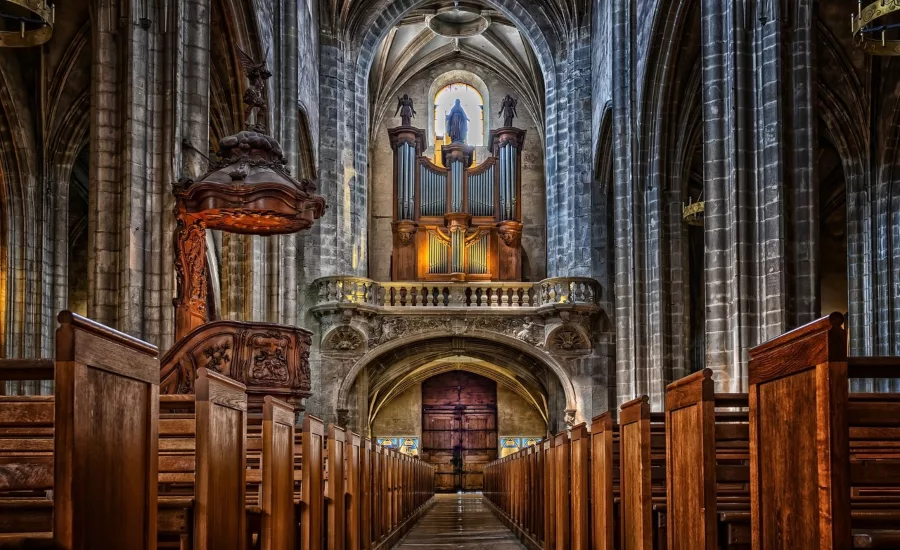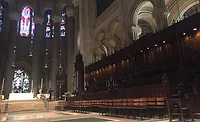Protecting Faith-Based Communities
Part 1 of 2.

Across the United States, Americans congregate in houses of worship. However, those soft targets are vulnerable, and recently, have been attractive targets for crime, mass shootings and other threats.
The reoccurrence of such violent incidents have forced some houses of worship to increasingly focus more efforts on security. For instance, a Catholic school in an Omaha, Neb. will begin stationing armed off-duty officers to protect students during school-day masses. The St. Columbkille security program will use ununiformed volunteers who are affiliated with the parish, including parents of children in the K-8 school. According to a news report, an Omaha Archdiocese official says he knows of no other schools or parishes considering a similar program.
With an overall goal of reduced crime, improved safety and peace of mind to house of worship staff and congregants, there are many steps that houses of worship can take to secure their facilities. In addition, there are multiple agencies and experienced security consultants that can assess threats and provide resources, training and advice to houses of worship.
One of the agencies focused on helping house of worship is the DHS Cybersecurity and Infrastructure Security Agency (CISA), responsible for protecting the nation’s critical infrastructure from physical and cyber threats. Scott Breor, Associate Director within CISA’s Infrastructure Security Leadership Division team, oversees the office of security programs and leads the division’s efforts in vulnerability and security gap analysis, support to special events and training on topics, including active shooter preparedness, suspicious activity reporting and improvised explosive device (IED) awareness and bomb threat management.
The Infrastructure Security team develops programs and tools designed to help houses of worship be prepared and mitigate active shooter events.
“Within CISA, we have chemical inspectors all across the United States, cybersecurity advisors and protective security advisors that meet with houses of worship, provide them training, perform security assessments and build their capacity to assess and mitigate threats,” says Breor.
Many Challenges Ahead
“Each place of worship is unique and has its own challenges, and there are many factors to consider. We cannot do a ‘one size fits all’ approach because of the age of the church, the size, the design and even the location make a big difference as to the types of protocols that are recommended,” says Patrick Fiel, a national security consultant with more than 40 years of experience in managing security and law enforcement organizations. He also specializes in providing security consulting services to houses of worship, schools, healthcare and enterprises.
With respect to unique risks, Breor says, “What we have learned in engaging with houses of worships, similar to what we have learned with K-12, is that they lack funding. Many of them are syncing resources back into the patrons that visit their facility, instead of investing those resources in their security. Fortunately, at the Department of Homeland Security, we have a non-profit security program that houses of worship can apply for and receive funds,” says Breor.
Having an online presence presents multiple challenges to the faith-based communities, as well. “They post their schedules online to alert church attendees to any events and mass times. If there is a nefarious actor who wants to harm congregants, they will know when that house of worship will be holding services and when people will be there,” says Breor.
Another challenge houses of worship may face is their lack of resources to hire professionals with security background or the fact that most of their security staff lack expertise. “There’s a lot of uniqueness in that,” notes Breor. “But we try to leverage some of those challenges by pointing out that there is likely a congregant that has either a military background, or a local law enforcement officer who has some type of security experience. We try to point out some of those available resources and recommend they form a Threat Assessment Team to focus on security, so that church staff can focus on servicing the needs of the patrons that visit them and to ensure they maintain an open and inviting environment.”
Houses of worship traditionally hold many critical assets, both inside and outside, such as images, relics and other materials in holy areas like chapels, altars and shrines, and many other expensive equipment and arts that hold sacred and symbolic meanings. “One of the challenges I’ve come across is how churches secure their assets,” says Bob Chauncey, Church Safety Security Consultant and Public Safety Chaplain. He serves on the Board of Directors at the Norfolk, Va. FBI InfraGard Chapter. Previously, he served as Deputy Sheriff & Sheriff’s Chaplain, Director of Asset Safety Equipment, State Chaplain with the Virginia State Crime Clinic, as Police Officer for the City of Portsmouth, VA Police Department and in many other roles.
“Churches also have on display musical instruments that have value to the common thief. Recently, houses of worship have been replacing chalices and other sacred, high-quality materials, usually made of gold or silver, with materials of lesser quality as they continue to experience not only attacks but thefts, as well,” says Chauncey.
Another challenge Breor has experienced is houses of worship staff who want to try to save the souls of criminals. “They were welcome to our advice with respect to security, but they also they did not want to inhibit an assailant because they thought it is their job to save the soul of a bad actor,” Breor says.
Chauncey has encountered similar views on rare occasions. “I once met with church staff and congregants who were upset that there was an armed security personnel walking around. I asked them, ‘What if someone comes in and wants to attack the building and people?’ and their response was, “God will protect us,” says Chauncey.
Another challenge is a resistance to lock doors, adds Chauncey. “People have to realize that there’s a danger and protection is needed. In the First Baptist Church in Sutherland Springs, 26 people were fatally shot and another 20 were injured. The first victim was found in the parking lot. Houses of worship should make sure they are securing their perimeters and all entrances that can lead the perpetrator inside the building. Before or when the service starts, lock your doors. Any side, back and main entrance doors should be locked. In addition, the doors should be monitored at all times.”
Pushback from congregants on security technology stationed in and outside the worship building isn’t one of the challenges Breor sees. “Sadly, this is where we are now. We have been exposed to many events, such as the Sutherland Springs, the 2019 Sri Lanka Easter bombings and Pittsburgh’s Tree of Life shooting in 2018. People want to have peace of mind as they go about their daily lives, so technology around security has become normalized and accepted.”
Fiel holds a similar view, as he has been successful in working closely with leadership teams at houses of worship. “Churches and places of worship are supposed to be a place where a community can gather and be safe, but after the recent attacks on houses of worship, congregants are taking a closer look at their overall security and their protocols. The ones that I have worked with are very receptive to my assessments and recommendations,” he says. He notes, however, that it is important that leadership teams communicate with their congregants about the recommendations and solutions that require technology, as “they do not want the church or place of worship to look or feel like a prison,” he says.
Part 2 of this series is available here. What initiatives and programs has your house of worship recently implemented? Feel free to email me at henriquezm@bnpmedia.com for any comments.
Looking for a reprint of this article?
From high-res PDFs to custom plaques, order your copy today!





